Self-milling wood and wood
Processing lumber, cutting in loops, making technological holes and recesses, wood carving - all this can be done by such a device as a router. Moreover, this can be not only professional equipment, but also relatively inexpensive manual copies. But working with a manual wood router requires knowledge of some techniques and rules. All this is in the article.
The content of the article
What is a router and what is it for
A router is a device for processing wood or metal. They process flat and shaped surfaces, also form technological recesses - a groove, a ridge, recesses for installing hinges, etc. According to the installation method, there are stationary machines (there are different types for performing different operations), and there are hand-held mills. Manual electric milling cutters are a versatile tool that allows you to carry out any operation. To change the operation, you just need to change the nozzle - the cutter and / or its location on the part.
The machines are mainly used for mass production. In them, the cutter is stationary, and the workpiece moves along a certain trajectory. When working with a hand router, the situation is the opposite - the workpiece is fixed motionless, the router is moved. When processing large volumes of identical parts, it is more convenient to fix the hand router on a horizontal surface, making something similar to a milling machine.

Homemade milling machine - a horizontal plane with a hole in the middle, to which a manual router is attached from below
There are many different types of milling machines, but for the DIY or semi-professional use, the versatile is more suitable. Various cutters and special devices are installed in them, which allows you to perform any operation. It just takes more time and skill to complete them than on a specialized machine.
What can be done with a hand router:
- grooves and grooves of any shape (curly, rectangular, complex shapes);
- through holes and blind;
- process the edges and ends (can be made straight, can be curly);
- cut out complex details;
- to apply inscriptions, patterns, drawings to the surface;
- copy details.
Similar operations are used in joinery, furniture manufacturing and assembly. Even cutting in a lock or hinges on the door - this can also be done by a hand router. Moreover, it will do it much faster and more elegantly than similar operations, but performed with a hand tool.
Preparation for work and care
To understand the principles of working with a hand router, it is advisable to have at least a general idea of its structure and the purpose of the parts.
The structure and purpose of the main nodes
The manual electric milling cutter consists of a body in which the motor is hidden. A holder protrudes from the body, where the collets are inserted. Collets are small adapters that allow you to use cutters with different shank diameters. A cutter is already inserted into the collet and tightened with a clamping bolt (on some models it is fixed with a button).
Another important part of the hand router is the platform, which is connected to the body using two rods.The platform is usually made of metal. There is a sliding plate on the underside of the platform. It is made of a smooth material that ensures the smooth running of the tool as it moves over the part.
Setting the parameters of the router is done using:
- Handles and jackals adjust the milling depth. The tuning step is 1/10 mm.
- Speed control. Changes the rotational speed of the cutter. To begin with, you should try to work at low or medium speeds - it is easier at first to guide the instrument.
Also, there is an on / off button on the case, there may also be a lock button. Here are all the nodes in a nutshell. In addition, there is also a parallel stop that is quite convenient to use. It can be simple or adjustable - you can move the cutting part slightly to the right or left.
Care
From the factory, the equipment is lubricated, so, in principle, no additional operations are required. But it is necessary to keep the equipment clean - it is necessary to clean off the dust more often, change the lubricant if necessary. Lubrication is needed for moving parts - guides. You can use liquid aerosol lubricants (preferable), but you can also use conventional greases such as "Litol". But, when using thick lubricants, you will have to periodically remove them, as chips and dust stick, it becomes difficult to work. When using light aerosol formulations, there is practically no sticking.
In order for the sole to glide easily, you can lubricate it with silicone grease. This is especially useful when working with templates. Then the tool literally slides, goes smoothly and without jerks.
Rotational speed
Work with a hand router on wood, composite, plywood, etc. starts with setting the basic parameters. First you need to set the rotation speed. It is selected depending on the selected cutter and the stiffness of the material and the characteristics of the cutter, so you should look for exact recommendations in the operating instructions.
Securing the cutter
Next, a cutter is installed. Most branded cutters have marks on which you can navigate. If they are not there, then the minimum must be clamped at least 3/4 of the length of the shank (cylindrical part). Insert the cutter to the required depth (if necessary, having previously installed the collet - adapter cartridge for different cutter diameters), secure the shaft, tighten with an open-end wrench until it stops (but do not overtighten).
If the model is simple, two keys are needed. They do not provide for a shaft locking mechanism; you will need to hold it with the second key. The middle class devices have a lock button. Clamping it, tighten the cutter with an open-end wrench. In expensive models, in addition to blocking, there is a ratchet by which you can navigate.
Setting the milling depth
Each model of a hand router has a certain overhang - this is the maximum depth to which this unit is able to process the material. The maximum milling depth is far from always required, then its adjustment is required. Even if you need to milling to a great depth, so as not to overload the cutter and the unit, you can divide it into several levels. There is a revolving stop for this. This is a small disc under the bar with a number of stops of different heights - legs. The number of legs is from three to seven, and more does not mean better. It is much more convenient if it is possible to adjust the height of each leg. This shows the class of the equipment. To secure the turret stop in the desired position, there is a latch, usually made in the form of a flag.
Setting the milling depth on a hand router takes place in several stages:
- The tool is placed on a flat surface, the clamps are released, the hand is pressed so that the cutter rested against the surface.
- The revolving stop is released by unscrewing its lock.
- Depending on what depth of milling is needed, choose the leg of the turret stop. The disc with legs is turned into the desired position.
- The screw is not fixed, but hold the bar with your finger, move the movable pointer so that it coincides with zero (in the photo above).
- The bar is raised to the milling depth mark, after which the turret lock is lowered (pictured below).
Now, when installed on the workpiece and pressing on the upper part, the cutter will enter the part at the set distance.
Good routers have a wheel for fine adjustment of the milling depth. It allows you, without knocking down the settings (you do not need to repeat the entire operation), to correct the depth, albeit within small limits (in the photo above, this is a green wheel).
Milling cutters for hand router
Milling cutters are a cutting tool that processes and shapes a surface. They consist of a cylindrical part, which is clamped by collets in the unit holder, and a cutting part. The cylindrical part can be of different diameters. Choose a collet for which your device has. The shape and location of the knives of the cutting part determines the look that the wood receives after processing. Some cutters (for edges) have a thrust roller. It sets the distance from the cutting surface to the workpiece.
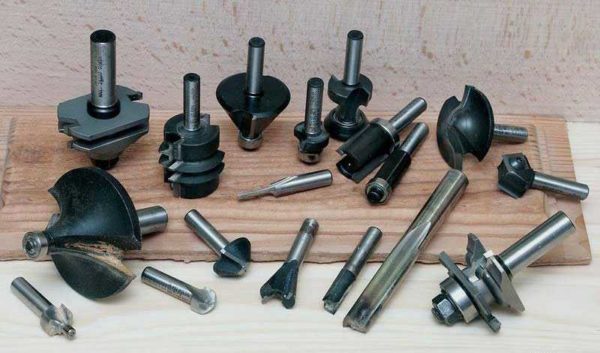
Working with a manual router for wood requires a number of cutters. This is a small part of what exists
Cutters are made from different metals and alloys. For processing softwood - pine, spruce, etc. - use conventional nozzles (HSS), for hard species - oak, beech and others - from hard alloys (HM).
Each cutter has a certain resource and maximum speed at which normal operation with minimum runout is ensured. Do not exceed the recommended speed - this can cause damage to the router. It also makes no sense to sharpen the cutter if it is dull. This is done on special equipment (costing about $ 1000), where you can set the required sharpening angle. Nothing good will come of it by hand. So blunt ones are easier (and cheaper) to replace, since they cost relatively little.
Popular types
There are a number of types of router bits that are most commonly used.
- Edging. Serve for processing the side surfaces of workpieces. With their help, you can make even or curly edges, you can form grooves and spikes for joining parts. It is this type of cutters that happens with a bearing at the end - it abuts against the part, setting the distance from the edge of the workpiece to the cutter.
- Groove. Serve for the formation of grooves and grooves of various shapes. They are:
- spiral (a) - mainly used to form technical grooves, for example, a tenon / groove connection;
- fillet (b, d) - for decorating the surface using grooves of different shapes, can be rounded, V-shaped or curly;
- dovetail (c, d) - to form a groove in the form of a trapezoid, this groove is used for open and hidden connection of parts;
- shaped (d) - with their help, they decorate the surface with grooves of complex shapes.
There are simple cutters formed from a single piece of metal, there are typesetting. Stacked ones have a shank - a base, a certain set of different cutting planes, a set of washers of different thicknesses. From these parts, you can independently form the required relief.
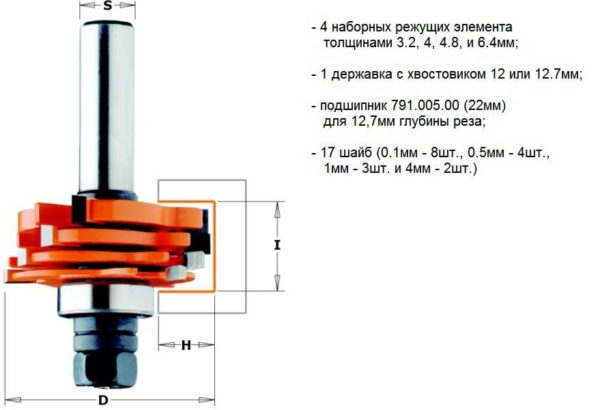
Inlaid cutter - a set of several cutting surfaces and washers, from which you can make a cutter of the required shape
These are the most popular types of cutters, but there are actually a lot of them. In addition to different shank diameters, there are different diameters of cutting surfaces, their heights, the location of the knives relative to each other, etc.In general, for do-it-yourself milling, you usually need about five of the most common cutters. They are usually present all the time, and the rest are purchased for specific types of work.
Principles of working with a hand router
An electric milling cutter is a rather dangerous thing - sharp cutting parts rotating at high speed can cause serious injuries, and chips flying from under the tool too. And although most models have a protective shield that reflects the main stream of chips, safety glasses will not interfere. So working with a manual wood router requires attention and concentration.
General requirements
Working with a manual wood router will be easier and more pleasant, the products will be of normal quality if certain conditions are met:
- The cutter must be sharp. It is difficult to assess this parameter "by eye", therefore it is necessary to focus on the working moments: if the motor is very hot and / or the treated surface is not smooth (they say "dirty"), then the cutter is dull. It needs to be replaced.
- The workpiece to be processed must be firmly and securely fixed. You will not get anything good on a jumping and twitching workpiece.
- Small stock removal depth in one pass. The more wood you cut in one pass, the greater the load on the cutter. This leads to a decrease in the rotational speed, which increases the load more. Further - in a circle. Therefore, if a greater depth of processing is required, it is better to split it into several passes.
- When replacing the cutter, the unit must be de-energized. And not with a switch, but remove the cord from the outlet. This will eliminate the possibility of involuntary activation.
Requirements are not as complex, but meeting them is the key to good work and safety. Well, the main requirement is that the milling cutter must be driven evenly, without jerks, jerks. If strong beating is felt, change the speed. Most often it needs to be reduced, but in general it is worth focusing on the manufacturer's recommendations (available on the packaging).
Edging - Working with a Template
Processing the edge of a regular board is easier and faster to carry out on a thickness gauge, but if it is not there, a hand router will also cope, but it will only take more time. There are two ways: without a template and with a template. If this is your first experience with a router, it is better to use a template. When processing the edges of the boards, straight edge cutters are needed, and, most likely, you will need two - with a bearing at the beginning and at the end of the cutting part (pictured).
As a template, you can use an already processed board or, for example, a building rule. The length of the template should be slightly larger than the length of the workpiece - by 5-6 cutter radii on each side. This will make it possible to avoid the cutter "diving" into the material at the beginning and at the end. One important point: the horizontal plane (perpendicular to the workpiece) must be flat. In any case, its curvature should not be greater than the gap between the bearing and the cutting part, otherwise the cutter will touch the template, which is very bad - it becomes imperfect and the applied irregularities will be displayed on other copies.
If the width of the part is not more than the length of the cutting edge
The cutters have a cutting part of different lengths, but the larger the cutting part, the more difficult it is to work - more effort has to be made to hold the unit. Therefore, it is easier to start with a medium cutter. The order of processing the edge with a router (with a template) is as follows:
- Set the template so that it sets the required flat surface - retreating the required distance from the edge.
- The workpiece with the template is securely attached to the table or any other horizontal surface.
- Install a cutter with a roller in the middle. It is set so that the roller rolls along the pattern, and the cutting part along the part.To do this, the cutter is installed on a fixed workpiece with a template, a cutter disconnected from the network is placed, the position of the nozzle is adjusted, and it is clamped.
- Set the cutter in working position - lower the body, clamp it.
- They turn on a manual router, lead them according to a template. The travel speed is determined by the depth of treatment. You will feel everything yourself.
- How to drive a router? Pull or push? Depends on which side you are on. If the workpiece is on the left - push, if on the right - pull. You can also navigate by the flight of the chips - it should fly forward.
That's all, actually. After you have finished the passage, evaluate the result, remove the clamps.
By the way, this is another way to remove a quarter along the edge of the workpiece or in some part of it. To remove a quarter, set the cutting part so that the machining is at the specified depth.
Changing the cutter to a curly (fillet) and shifting the template or using the stop included in the kit, you can apply a longitudinal drawing to the workpiece (in the photo below).
In general, this milling technique is quite convenient. For the first steps in woodworking, this is the best way to "fill your hand", then it will be possible to level the edges even without guides.
Width is greater than cutting length
What if the thickness of the workpiece is not more than the length of the cutter's cutting edge? In this case, the work with a manual wood router continues:
- Remove the template, use the same cutter again. Only in this case, the already machined part of the workpiece will be the template - the bearing will roll over the newly milled part. Rearrange the cutter so that you can cut as much as possible. The holder will not move too much, but you will still be able to process some part.
- After that, take another nozzle - with a bearing at the end, turn the workpiece over so that the machined part is on the bottom. Fasten on the table with clamps. Install the nozzle with the lower roller so that the bearing rolls over the machined part. Thus, you completely copy the already processed part.
Now the edge is completely finished on one side. If necessary, repeat with the second side. In general, in order to master the work of a manual router for wood, you will need several "rough" blanks. Choose from those that you do not mind throwing away - at first there will be a lot of jambs, then gradually learn.
Getting curved and curved edges
If you need not even, but rounded or any other shape of the edge, you need to look at the state of the existing edge. If the workpiece is more or less level, take the required edge mill, set it up and process the surface as described above. If the surface is too curved, it is first brought to a normal state and then milled.
This is necessary because the bearing roller rolls over the surface and if there are flaws, they will be copied. Therefore, act consistently - first level, then - give curvature.
If a curved surface is generally boring, a template is cut out. The drawing is applied to plywood with a thickness of 8-12 mm, at first it can be cut out with a jigsaw, therefore the edge is brought to an ideal state with a milling cutter.
In this case, you will also have to work with a milling cutter, but so far without a template. When the surface is perfect, the template is fixed to the workpiece and then the work already described above with a manual wood router. Just one thing: if you need to shoot a lot of material in some places, it is better to do it with a jigsaw, for example. Otherwise, the cutter will quickly become dull.
Video tutorials on working with a hand router
When installing doors, it is necessary to cut in the hinges, how to do this with a router - in the next video (there is also how to make a groove, for example, for installing an extension).
How to make a homemade milling machine from laminate images (plywood can be used) and how to make a spike connection for drawers (a table, for example) - in the next video
Working with a hand router for wood is well shown in the next video, but it is in English. Even if you don't know English, take the time to have a look. Many operations will become clearer.

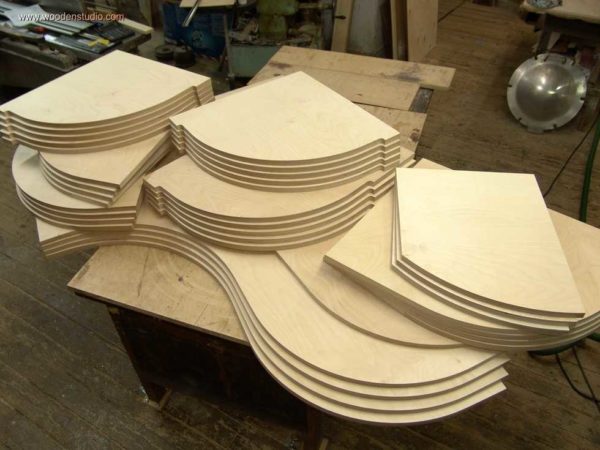
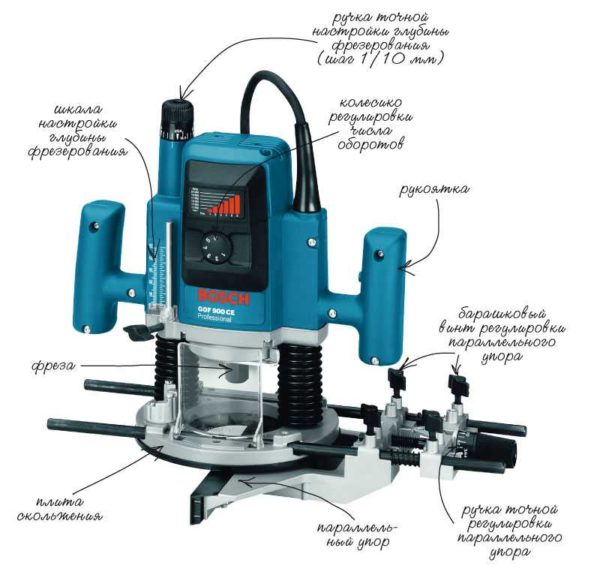
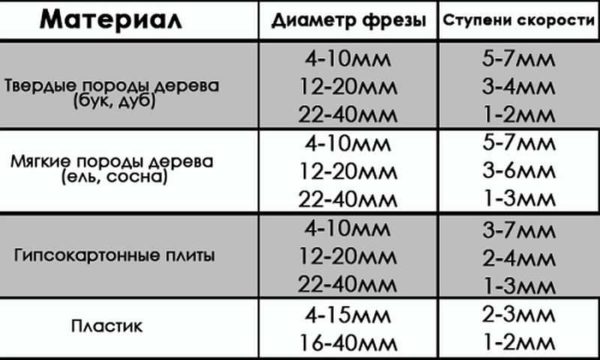
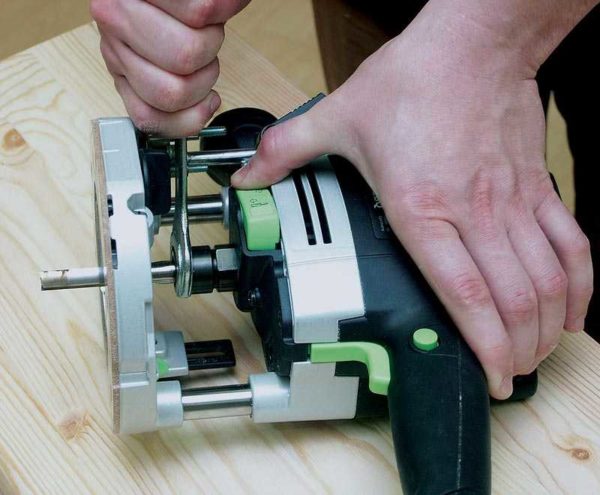
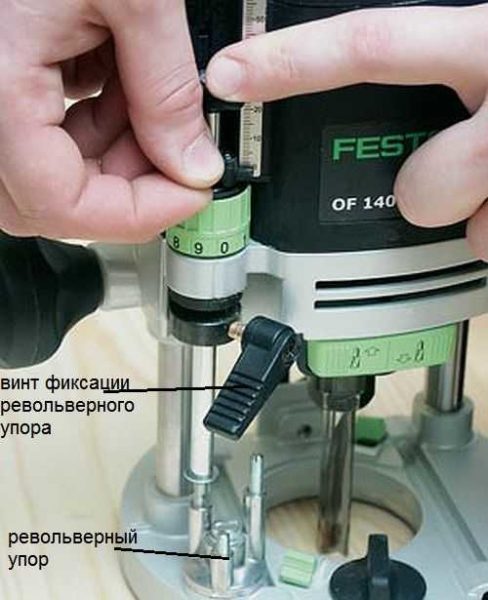
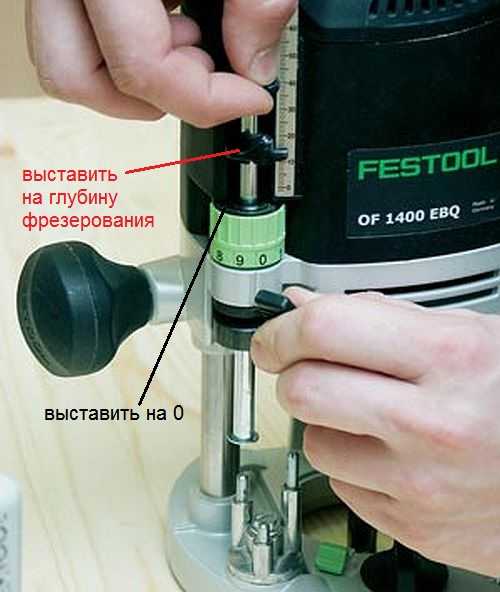
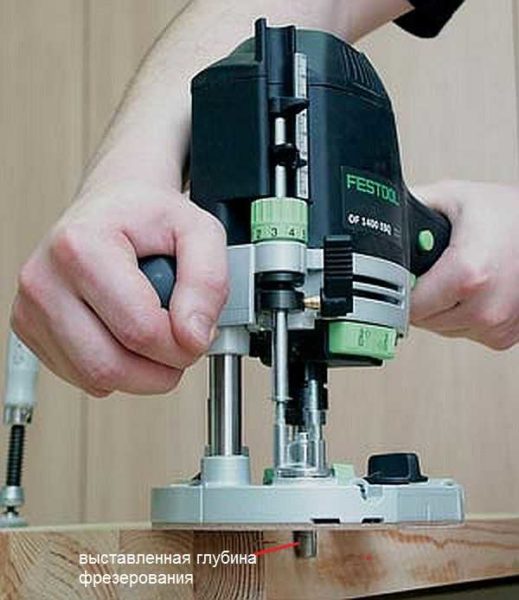
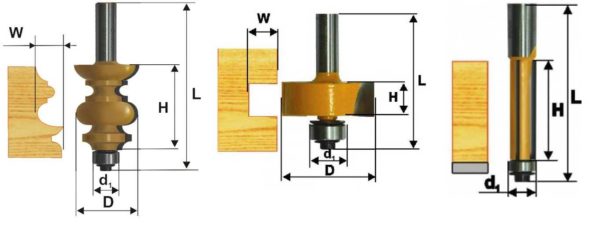
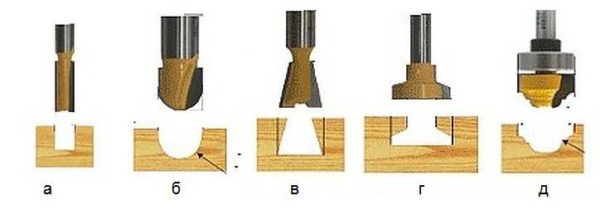
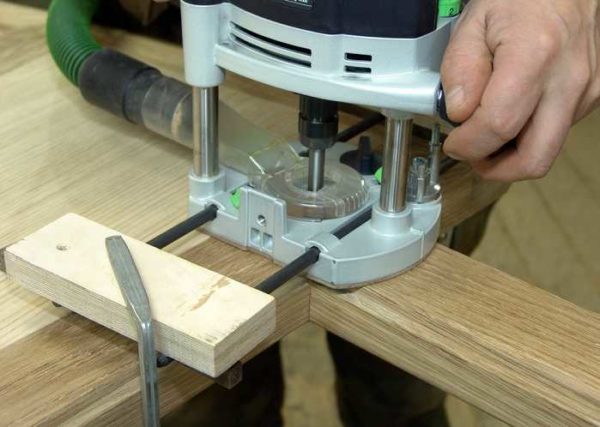
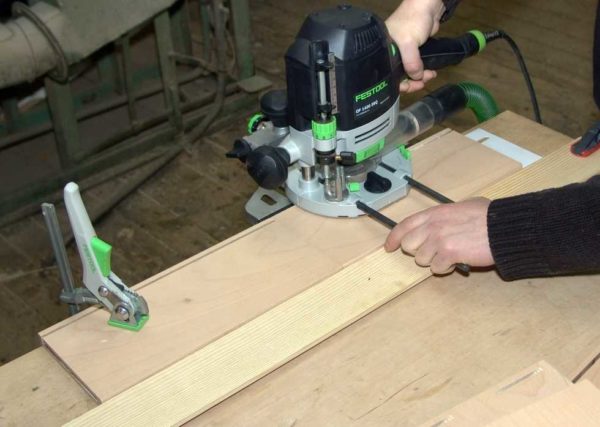
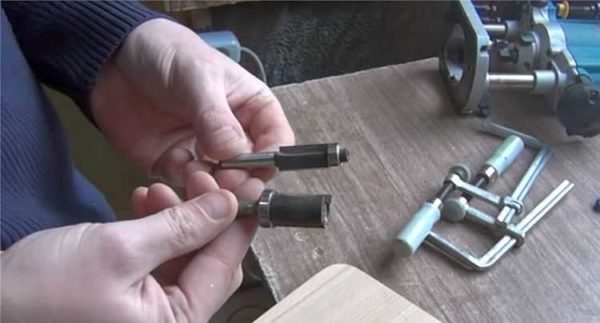
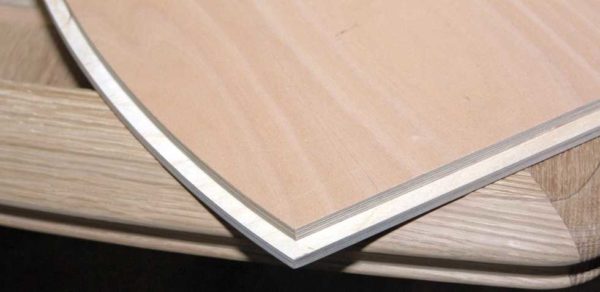
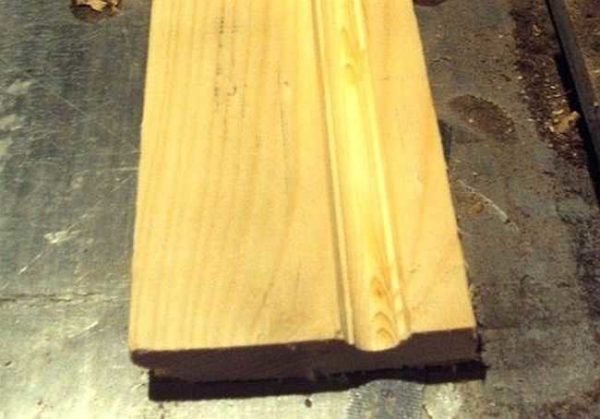
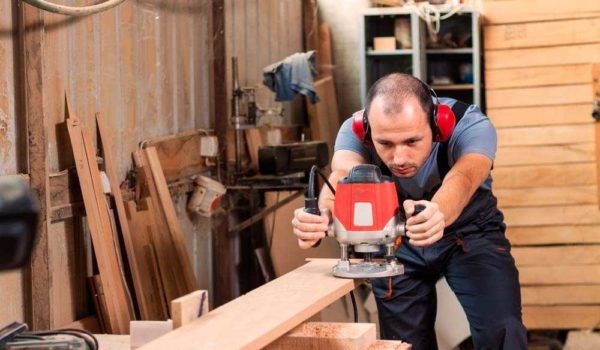
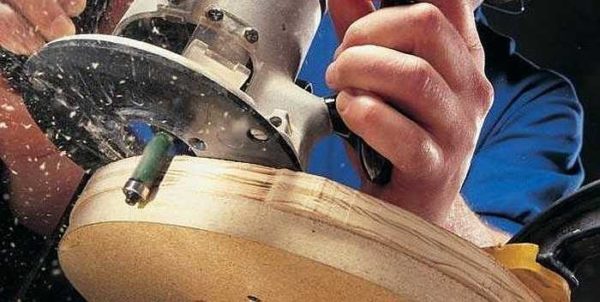
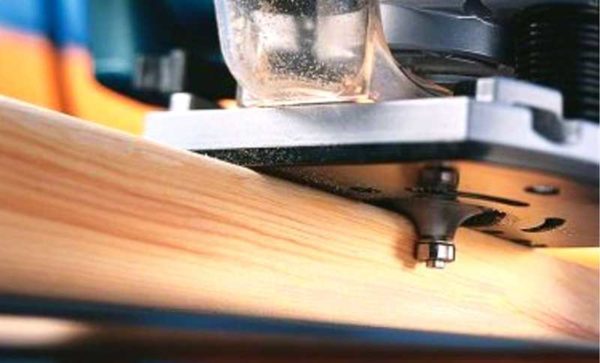
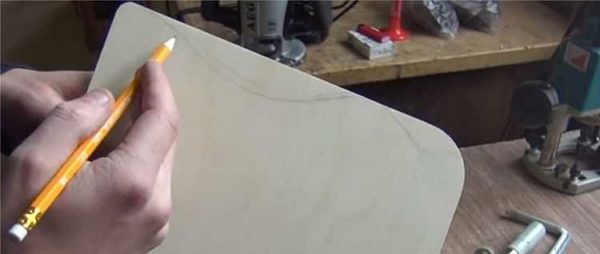
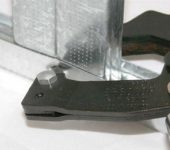
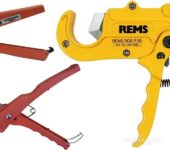
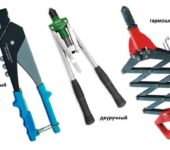
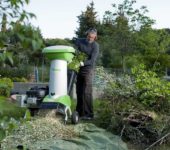
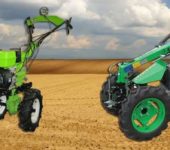





Very interesting and informative, thank you very much.
An English-language video, obviously superfluous (((especially for beginners. And so, yes, everything is interesting ...
In the table that I am looking for on the network, the rotation speed is indicated in mm. Or is it the speed of the router, or the thickness of the removal per pass? Apparently, all the same, the first. But, then, why mm?
And yet, the speed is more interesting not for GVL / GKL, but for plywood, chipboard, laminated chipboard.